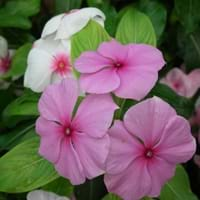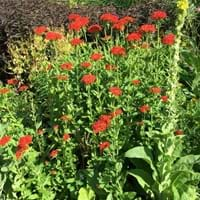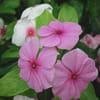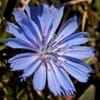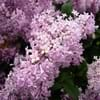Life Span
Perennial
Perennial
Type
Flowering Plants, Shrubs
Perennial
Origin
Madagascar
Eastern Europe, Kazakhstan, Mongolia, Northwestern China, Russia
Types
Purple vinca, Vinca, cherry red, strawberry color
not available
Number of Varieties
Not Available
Habitat
Subtropical climates, Tropical regions
Banks
USDA Hardiness Zone
4-9
3-8
Sunset Zone
A1, A2, A3, H1, H2, 1a, 1b, 2a, 2b, 3a, 3b, 4, 5, 6, 7, 8, 9, 10, 11, 12, 13, 14, 15, 16, 17, 18, 19, 20, 21, 22, 23, 24
A1, A2, A3, 1a, 1b, 2a, 2b, 3a, 3b, 4, 5, 6, 7, 8, 9, 10, 14, 15, 16, 17, 18, 19, 20, 21, 22, 23, 24
Habit
Clump-Forming
Upright/Erect
Flower Color
Magenta, Pink, Rose
Red, Orange, Rose, Salmon, Peach, Orange Red
Flower Color Modifier
Not Available
Bicolor
Fruit Color
Not Available
Brown
Leaf Color in Spring
Dark Green
Green
Leaf Color in Summer
Dark Green
Green
Leaf Color in Fall
Dark Green
Green
Leaf Color in Winter
Dark Green
Light Green
Leaf Shape
Oval
Ovate elongated
Plant Season
Fall, Spring, Summer, Winter
Spring, Summer
Sunlight
Partial shade
Full Sun, Partial Sun, Partial shade
Type of Soil
Loamy, Sandy, Well drained
Clay, Loam, Sand
The pH of Soil
Neutral, Slightly Alkaline
Acidic, Neutral, Alkaline
Soil Drainage
Well drained
Average
Bloom Time
Fall, Spring, Summer
Late Spring, Early Summer, Summer
Tolerances
Drought, Pollution, Salt
Drought
Where to Plant?
Container, Ground, Pot
Ground
How to Plant?
Seedlings, Stem Planting, Transplanting
Divison, Seedlings
Plant Maintenance
Medium
Medium
Watering Requirements
Does not require lot of watering, Medium
Do not let dry out between waterings
In Summer
Lots of watering
Lots of watering
In Spring
Moderate
Moderate
In Winter
Average Water
Average Water
Soil pH
Neutral, Slightly Alkaline
Acidic, Neutral, Alkaline
Soil Type
Loamy, Sandy, Well drained
Clay, Loam, Sand
Soil Drainage Capacity
Well drained
Average
Sun Exposure
Partial shade
Full Sun, Partial Sun, Partial shade
Pruning
Prune ocassionally
In late autumn, Remove deadheads
Fertilizers
All-Purpose Liquid Fertilizer
All-Purpose Liquid Fertilizer
Pests and Diseases
Botrytis Blight, Canker, Crown rot, Pythium rot, Root rot
Aphids, Red blotch, Slugs
Plant Tolerance
Drought
Drought
Flower Petal Number
Single
Single
Foliage Texture
Medium
Medium
Foliage Sheen
Glossy
Glossy
Invasive
Sometimes
Sometimes
Attracts
Butterflies
Butterflies, Hummingbirds
Allergy
Intestinal gas, Nausea, Vomiting
Not Available
Aesthetic Uses
Beautification, Showy Purposes
Showy Purposes
Beauty Benefits
Not Available
No Beauty Benefits
Environmental Uses
Air purification
Air purification
Medicinal Uses
Chest pain, High blood pressure, Inflammation, Sore throat, Tooth ache, Wounds
Not Available
Part of Plant Used
Whole plant
Whole plant
Other Uses
Decoration Purposes, Showy Purposes, Used as Ornamental plant
Used as Ornamental plant
Used As Indoor Plant
Yes
No
Used As Outdoor Plant
Yes
Yes
Garden Design
Bedding Plant, Container, Edging
Bedding Plant, Feature Plant, Mixed Border
Botanical Name
Catharanthus roseus
LYCHNIS chalcedonica
Common Name
Madagascar periwinkle or rosy periwinkle
Maltese cross, Jerusalem cross, Burning love, Dusky salmon
In Hindi
Periwinkle
Maltese cross
In German
Immergrün
Malteserkreuz
In French
Pervenche
Maltese cross
In Spanish
Bígaro
cruz de Malta
In Greek
μυρτιά
σταυρό της Μάλτας
In Portuguese
Mirta
cruz de Malta
In Polish
Barwinek
krzyż maltański
In Latin
Periwinkle
Duces crucis
Phylum
Mollusca
Magnoliophyta
Class
Gastropoda
Magnoliopsida
Order
Geraniales
Caryophyllales
Family
Apocynaceae
Caryophyllaceae
Genus
Catharanthus
Lychnis
Clade
Not Available
Angiosperms, Core eudicots, Eudicots
Tribe
Not Available
Not Available
Subfamily
Not Available
Not Available
Number of Species
Not Available
Season and Care of Periwinkle and Maltese Cross Flower
Season and care of Periwinkle and Maltese Cross Flower is important to know. While considering everything about Periwinkle and Maltese Cross Flower Care, growing season is an essential factor. Periwinkle season is Fall, Spring, Summer and Winter and Maltese Cross Flower season is Fall, Spring, Summer and Winter. The type of soil for Periwinkle is Loamy, Sandy, Well drained and for Maltese Cross Flower is Clay, Loam, Sand while the PH of soil for Periwinkle is Neutral, Slightly Alkaline and for Maltese Cross Flower is Acidic, Neutral, Alkaline.
Periwinkle and Maltese Cross Flower Physical Information
Periwinkle and Maltese Cross Flower physical information is very important for comparison. Periwinkle height is 1.97 cm and width 2.96 cm whereas Maltese Cross Flower height is 60.00 cm and width 25.40 cm. The color specification of Periwinkle and Maltese Cross Flower are as follows:
Periwinkle flower color: Magenta, Pink and Rose
Periwinkle leaf color: Dark Green
Maltese Cross Flower flower color: Red, Orange, Rose, Salmon, Peach and Orange Red
- Maltese Cross Flower leaf color: Green
Care of Periwinkle and Maltese Cross Flower
Care of Periwinkle and Maltese Cross Flower include pruning, fertilizers, watering etc. Periwinkle pruning is done Prune ocassionally and Maltese Cross Flower pruning is done In late autumn and Remove deadheads. In summer Periwinkle needs Lots of watering and in winter, it needs Average Water. Whereas, in summer Maltese Cross Flower needs Lots of watering and in winter, it needs Average Water.
